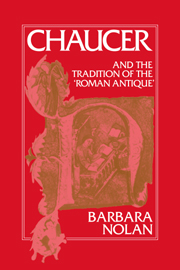Book contents
- Frontmatter
- Contents
- Acknowledgments
- List of abbreviations
- Introduction
- 1 Benoît de Sainte-Maure's Roman de Troie and the compositional practices of the roman antique
- 2 Plaits, debates, and judgments in the Roman de Thèbes, the Roman de Troie and the Roman d'Eneas
- 3 The poetics of fine amor in the French romans antiques
- 4 From history into fiction: Boccaccio's Filostrato and the question of foolish love
- 5 Boccaccio's Teseida and the triumph of Aristotelian virtue
- 6 Saving the poetry: authors, translators, texts, and readers in Chaucer's Book of Troilus and Criseyde
- 7 The consolation of Stoic virtue: Chaucer's Knight's Tale and the tradition of the roman antique
- Epilogue
- Notes
- Bibliography
- Index
5 - Boccaccio's Teseida and the triumph of Aristotelian virtue
Published online by Cambridge University Press: 11 September 2009
- Frontmatter
- Contents
- Acknowledgments
- List of abbreviations
- Introduction
- 1 Benoît de Sainte-Maure's Roman de Troie and the compositional practices of the roman antique
- 2 Plaits, debates, and judgments in the Roman de Thèbes, the Roman de Troie and the Roman d'Eneas
- 3 The poetics of fine amor in the French romans antiques
- 4 From history into fiction: Boccaccio's Filostrato and the question of foolish love
- 5 Boccaccio's Teseida and the triumph of Aristotelian virtue
- 6 Saving the poetry: authors, translators, texts, and readers in Chaucer's Book of Troilus and Criseyde
- 7 The consolation of Stoic virtue: Chaucer's Knight's Tale and the tradition of the roman antique
- Epilogue
- Notes
- Bibliography
- Index
Summary
In a deluxe bible, now known as the Bible of Malines, commissioned by King Robert of Anjou about 1340, there are two full-page illustrations that bear interestingly on Boccaccio's writing of the Teseida (c. 1339–41). The two illustrations, made by the miniaturist, Cristoforo Orimina, occupy a position of preeminence in the Bible, appearing before the beginning of the text and forming a sort of diptych. On the left-hand page, King Robert is portrayed, sitting on a throne, surrounded by personifications of eight virtues, whose identities – Justice, Fortitude, Prudence, Temperance, Generosity, Purity, Discretion, and Fidelity – are indicated by Latin inscriptions on their octagonal haloes (f. 3V). Beneath the feet of the virtues are depicted seven vices in the devil's company, and all of them are turned upside down. An inscription above the throne identifies the king: “Rex Robertus, rex expertus in omni scientia.”
The image of Robert surrounded by personified virtues epitomizes the king's manifest and abiding interest in the ideal moral conduct of rulers, while the inscription above the throne testifies to his fame as a patron of the liberal arts. Much earlier in his reign, in 1310, Robert had commissioned an illuminated copy of Aegidius Romanus' neo-Aristotelian treatise on princely virtue, the De regimine principum.
- Type
- Chapter
- Information
- Chaucer and the Tradition of the Roman Antique , pp. 155 - 197Publisher: Cambridge University PressPrint publication year: 1992



